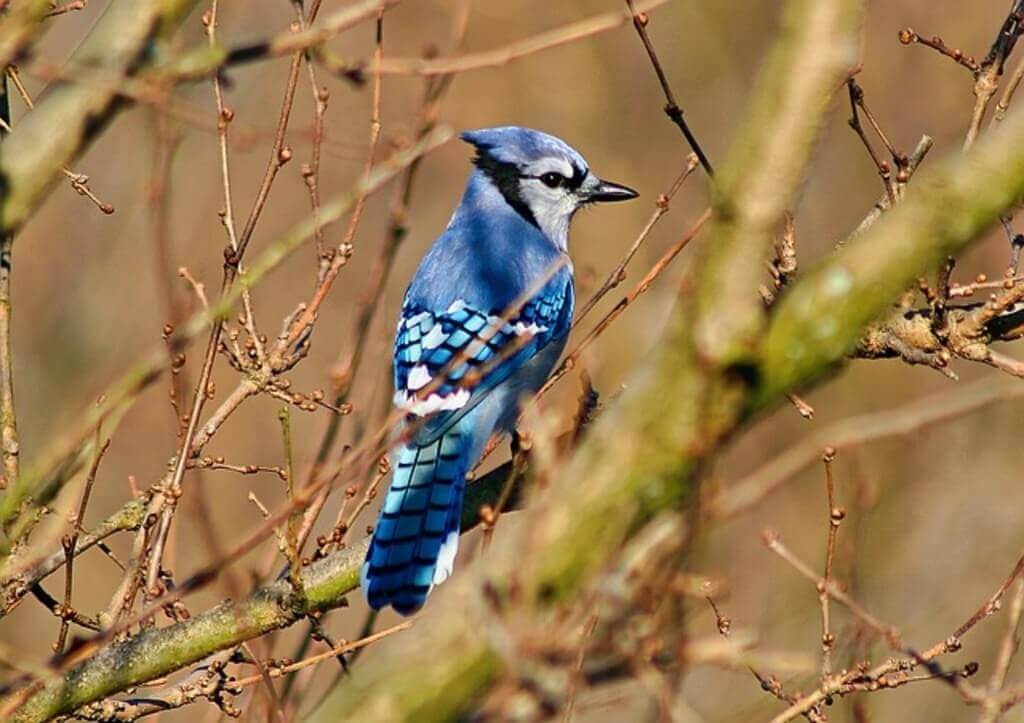What Does A Blue Jay Look Like? Prepare to be dazzled by the avian fashionista! With vibrant blue plumage, a distinctive crest, and a captivating presence, the Blue Jay is a sight to behold.
But that’s just the beginning. Join us as we dive into the enchanting details of this striking bird’s appearance and uncover its hidden wonders. Get ready to be amazed!
Table of Contents
- 1 Key Takeaways
- 2 What Does A Blue Jay Look Like
- 3 Size and Measurements
- 4 Vibrant Blue Plumage
- 5 Iridescent Feathers
- 6 White Body with Black Accents
- 7 Necklace-Like Band on Neck
- 8 Black Collar on Upper Chest
- 9 Prominent Crest on Head
- 10 Mood-Dependent Crest Movement
- 11 Striking Appearance
- 12 A Stunning Sight in Nature
- 13 Frequently Asked Questions
- 14 Conclusion
- 15 Author
Key Takeaways
- Blue Jays are medium-sized birds with a white body and black accents, including a necklace-like band on their neck.
- They have a prominent crest on their head that can be raised or lowered depending on their mood.
- The vibrant blue plumage of Blue Jays ranges from deep azure to light sky blue, with iridescent feathers creating a mesmerizing range of shimmering colors.
- The size and movement of the crest serve as visual cues for mood and behavior, and their call is described as loud and raspy.
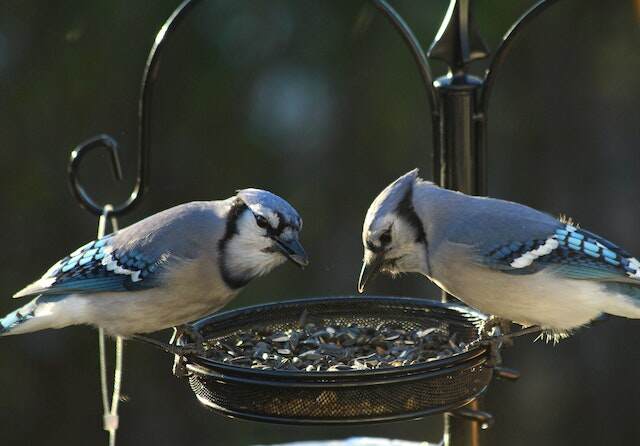
What Does A Blue Jay Look Like
A Blue Jay is a stunning bird with vibrant blue plumage, a white underbelly, and a distinctive crest on its head. It measures around 9–12 inches in length, weighs 2.5-3.5 ounces, and has a wingspan of 13–17 inches. Its striking appearance and sociable nature make it easily recognizable and beloved by bird enthusiasts.
Size and Measurements
Blue jays are medium-sized birds, measuring approximately 9–12 inches in length and weighing around 2.5-3.5 ounces.
They have an average wingspan of about 13–17 inches. In terms of body length, they have a compact build with a stocky appearance.
The tail of a blue jay is relatively short compared to its body length.
When comparing their size with other birds, blue jays fall within the mid-range, neither too large nor too small. Their size allows them to navigate through trees and brush with agility.
Now, transitioning into the subsequent section about their vibrant blue plumage…
Vibrant Blue Plumage
With a hue that is both striking and vibrant, the plumage of a blue jay displays a color intensity that surpasses that of many other bird species.
The vibrant blue feathers of the blue jay are a visual spectacle, capturing the attention of anyone who catches a glimpse of this avian beauty.
The iridescent plumage of the blue jay not only adds to its striking appearance, but also serves a functional purpose.
The blue feathers act as a form of camouflage, allowing the bird to blend seamlessly into its surroundings, especially when perched among the foliage.
This adaptation provides a valuable advantage in evading predators and maximizing the blue jay’s chances of survival.
The vibrancy of its plumage is not only visually pleasing, but it also signifies the blue jay’s health and vitality.
The intensity of the blue coloration can vary among individuals, with some displaying a deeper, richer shade than others. This variation adds to the uniqueness and individuality of each blue jay.
As we transition into the subsequent section about ‘iridescent feathers,’ it is important to note that the vibrant blue plumage of the blue jay is not the only captivating aspect of its appearance.
Iridescent Feathers
The iridescent feathers of the blue jay showcase a stunning display of refracted light, creating a mesmerizing range of shimmering colors.
The unique structure of the feathers, combined with their reflective properties, allows for the iridescent coloration observed in these birds.
The feathers of the blue jay have a complex arrangement of melanin granules and air spaces, which interact with light in a way that produces the vibrant hues seen on their wings and body.
As light hits the feathers, it is refracted and separated into its component colors, resulting in a beautiful play of blues, greens, and purples.
This phenomenon is known as structural coloration and is responsible for the captivating appearance of the blue jay.
The iridescent feathers not only serve as a visual spectacle, but also play a role in communication and mate attraction for these birds.
Moving on to the next section about the blue jay’s white body with black accents, we explore another aspect of its striking appearance.
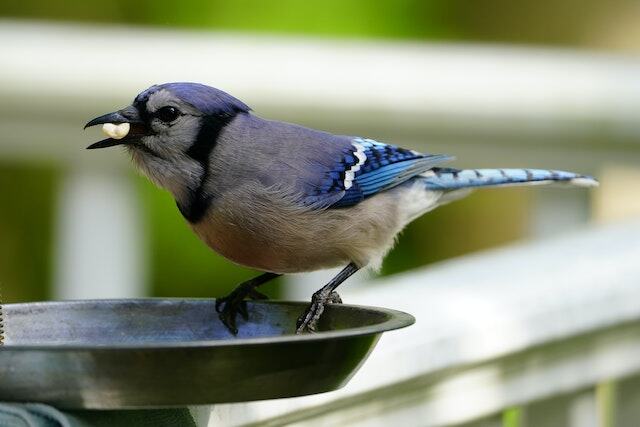
White Body with Black Accents
The contrasting appearance of the blue jay’s white body with black accents creates a visually striking and aesthetically pleasing combination. This unique coloration is just one of the many fascinating features of this bird species.
Here are four interesting facts about the blue jay’s appearance:
- Size variations: Blue jays are medium-sized birds, typically measuring around 9–12 inches in length and weighing between 2.5-3.5 ounces. However, there can be slight variations in size among individuals, with some being slightly larger or smaller.
- Habitat preferences: Blue jays are adaptable birds that can be found in a variety of habitats, including forests, woodlands, parks, and suburban areas. They are particularly fond of oak trees, as they provide both food and shelter.
- Breeding behavior: Blue jays are monogamous birds, forming long-term pair bonds. During the breeding season, males engage in elaborate courtship displays to attract females. Once a pair has formed, they work together to build a nest, typically located in the fork of a tree branch.
- Necklace-like band on neck: One distinctive feature of the blue jay is the necklace-like band of black feathers that encircles its neck. This bold black marking adds to the overall striking appearance of the bird, contrasting with the white feathers on its body.
The white body with black accents of the blue jay not only serves as a visually captivating feature but also provides important information about its size variations, habitat preferences, and breeding behavior.
Transitioning into the subsequent section about the ‘necklace-like band on the neck,’ we can further explore the intricate details of this remarkable bird’s appearance.
Necklace-Like Band on Neck
One distinctive feature that sets the blue jay apart is the striking necklace-like band of black feathers encircling its neck, adding to the overall allure of this remarkable bird’s appearance.
This colorful accessory, resembling ornamental jewelry, serves as a decorative neckband, enhancing the blue jay’s aesthetic appeal.
The band consists of a row of jet-black feathers that wrap around the bird’s neck, creating a visually striking contrast against its white body.
The intricate pattern and placement of these feathers give the blue jay a touch of elegance and sophistication.
This feature, reminiscent of a fashionable neckpiece, captures the attention of observers and showcases the blue jay’s unique sense of style.
The presence of such an elaborate neckband exemplifies the blue jay’s desire for innovation in its appearance.
Black Collar on Upper Chest
Exhibiting a distinctive contrast against its white body, the blue jay displays a black collar adorning its upper chest.
This black collar adds an element of visual intrigue to the bird’s overall appearance, drawing attention to its vibrant blue plumage and iridescent feathers.
The black collar serves as a striking accent, enhancing the blue jay’s aesthetic appeal and making it easily recognizable in its natural habitat.
The presence of this feature highlights the blue jay’s unique and captivating physical attributes, capturing the interest of those with a subconscious desire for innovation.
Transitioning seamlessly into the subsequent section about the prominent crest on the head, the blue jay’s black collar is just one of the many remarkable characteristics that make this bird a truly remarkable and fascinating species.
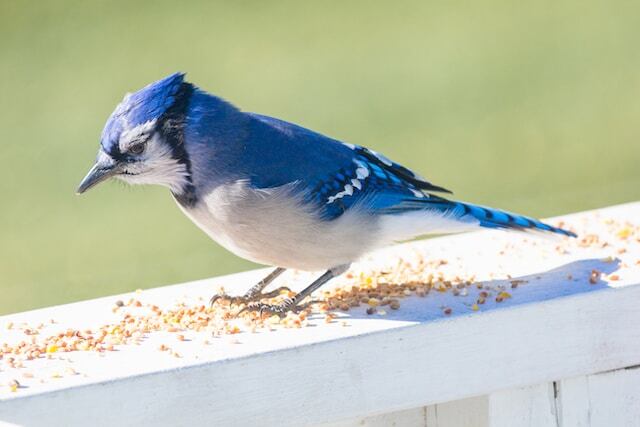
Prominent Crest on Head
Characterized by a prominent crest on its head, the blue jay possesses a striking physical feature that sets it apart from other avian species, with males typically having longer and more elaborate crests than females.
The crest behavior of the blue jay is quite fascinating, as it can be raised or lowered depending on the bird’s mood or behavioral context.
When the blue jay is calm or in a neutral state, the crest is often held in a relaxed position, lying flat against the head.
However, in moments of excitement or aggression, the crest can be erect and raised, giving the bird a more imposing appearance.
In terms of crest coloration, the blue jay’s crest is predominantly blue, matching its overall plumage.
However, it may also exhibit black markings or streaks, adding an interesting contrast to its vibrant blue feathers.
The size of the crest varies among individuals, but it generally extends from the forehead to the back of the head, giving the bird a distinctive silhouette.
Overall, the blue jay’s prominent crest is not only aesthetically appealing, but also serves as a visual cue for its mood and behavior.
Transitioning into the subsequent section about ‘mood-dependent crest movement,’ it is intriguing to explore how the blue jay utilizes this physical feature to communicate and interact with its environment.
Mood-Dependent Crest Movement
The movement of the blue jay’s crest is influenced by its mood, allowing the bird to effectively communicate and interact with its surroundings.
This mood-dependent crest behavior serves as a means of communication, conveying various messages to other blue jays and potential predators.
When the blue jay is in a calm or neutral state, its crest is usually held in a relaxed and lowered position.
However, when the bird is excited or alarmed, the crest is raised, creating a striking appearance that serves as a visual warning to potential threats.
Environmental factors also play a role in crest movement, as the bird may adjust the position of its crest in response to changes in its surroundings, such as the presence of other blue jays or the proximity of predators.
This dynamic display of crest movement not only adds to the blue jay’s aesthetic appeal, but also enhances its ability to effectively communicate with its surroundings.
Transitioning into the subsequent section about the blue jay’s striking appearance, the crest’s movement is just one aspect of the bird’s overall appearance that makes it a visually captivating species.
Striking Appearance
The previous subtopic discussed the mood-dependent crest movement of blue jays, highlighting their ability to communicate their emotional state through physical cues.
Building upon this fascinating aspect of their behavior, the current subtopic examines the striking appearance of blue jays.
When it comes to color variations, blue jays are predominantly known for their vibrant blue plumage, which ranges from a deep sapphire to a lighter azure hue.
However, they are not solely defined by their blue coloration; they also possess unique markings that add to their visual appeal.
One such marking is the striking black necklace-like band around their necks, which contrasts beautifully with their blue feathers.
Additionally, blue jays have a distinctive call that can be described as a loud, raspy ‘jay-jay’sound. This call is not only recognizable but also contributes to their overall striking appearance.
With their vivid blue feathers, distinctive markings, and unique vocalizations, blue jays are truly a stunning sight in nature.
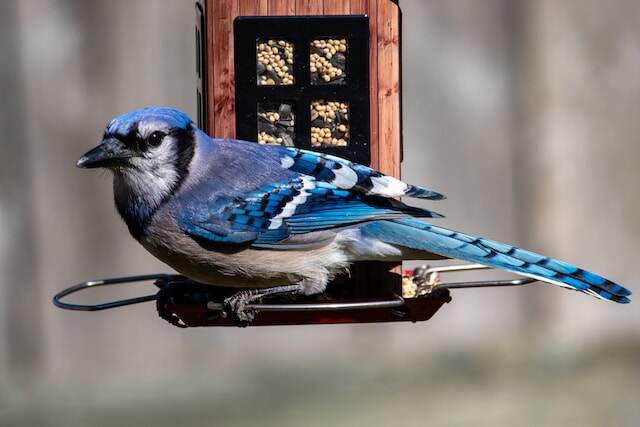
A Stunning Sight in Nature
Featuring vibrant blue plumage, unique markings, and a distinctive call, blue jays present a remarkable spectacle in the natural world. With their striking appearance, blue jays captivate the attention of observers.
Their majestic aerial acrobatics add to their allure, as they gracefully soar through the sky, showcasing their agility and nimbleness.
Additionally, blue jays are known for their unique vocalizations, which range from loud and raucous calls to soft and melodic songs.
These vocalizations serve various purposes, such as territorial defense, communication within their flock, and attracting mates.
Blue jays also play an important ecological role in the ecosystem. As omnivorous birds, they consume a diverse diet that includes fruits, insects, nuts, and seeds.
This foraging behavior contributes to seed dispersal and pollination, making blue jays integral to the maintenance of plant populations and biodiversity.
Overall, blue jays are a stunning sight in nature, combining their vibrant plumage, remarkable aerial displays, unique vocalizations, and ecological significance, making them a fascinating subject of study and admiration.
Frequently Asked Questions
What is the lifespan of a Blue Jay?
What factors influence the lifespan of a Blue Jay? How does Blue Jay reproduction, nesting habits, and predators impact their survival? Understanding these aspects provides valuable insights into the dynamic life of this species.
How do Blue Jays communicate with each other?
Blue jays communicate with each other through a combination of vocalizations, body language, and social interactions. They use a variety of calls, including alarm calls and territorial calls, to convey information to other members of their group.
What is the diet of a Blue Jay?
The Blue Jay’s diet consists primarily of acorns, nuts, and seeds, which they forage for in trees and on the ground. They also eat insects, fruits, and occasionally small vertebrates. Their preferred foods vary seasonally, with a preference for nuts in the winter.
Do Blue Jays migrate during the winter?
Blue jays do migrate during winter. They typically travel in flocks and can cover long distances. Migration is driven by the search for food, as blue jays rely on acorns and other nuts which may become scarce in winter.
Are Blue Jays considered to be aggressive birds?
Blue jays are known for their aggressive behavior and territorial disputes. They exhibit this behavior during nesting season to protect their eggs and young. Understanding their nesting habits can help mitigate conflicts with these birds.
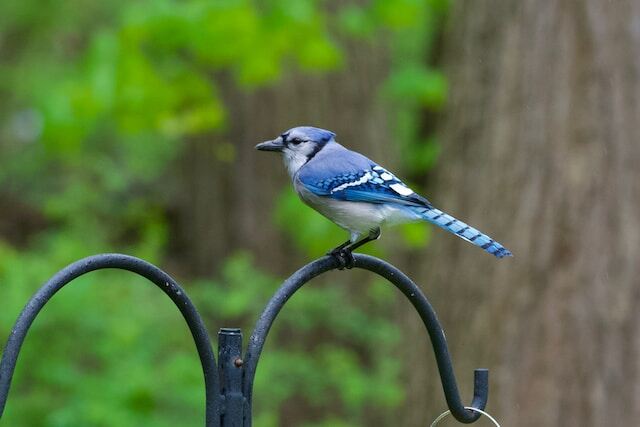
Conclusion
In conclusion, the blue jay is a visually captivating bird that boasts a striking appearance. Its size typically ranges from 9 to 12 inches, with a wingspan of about 13 to 17 inches.
The blue jay’s most distinguishing feature is its vibrant blue plumage, which is truly a sight to behold.
The feathers of the blue jay are iridescent, meaning they appear to change color depending on the angle of light. This adds to the bird’s allure and makes it even more visually appealing.
Additionally, the blue jay has a white body with black accents, such as its distinctive necklace-like band on the neck.
This band serves as a beautiful contrast against the bird’s blue feathers, further enhancing its overall appearance.
Another prominent feature of the blue jay is the crest on its head, which can be raised or lowered depending on the bird’s mood.
This unique characteristic adds a touch of elegance to its already striking presence.
Overall, the blue jay is a stunning sight in nature. Its vibrant blue plumage, iridescent feathers, white body with black accents, and prominent crest all contribute to its visually captivating appearance.
It is truly a remarkable creature that leaves a lasting impression on anyone fortunate enough to witness its beauty.
The blue jay’s ability to evoke awe and wonder with its stunning appearance is nothing short of extraordinary.

